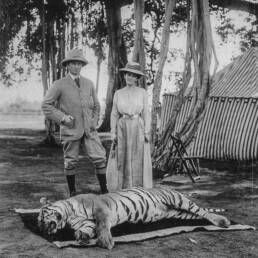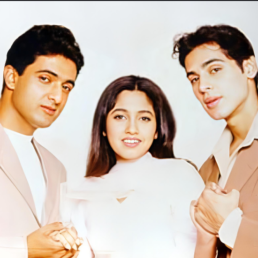SRK’s latest blockbuster, “Jawaan,” brings back one of the most familiar tropes of cinema – the double role. Today, we take a stroll down memory lane at the origins and evolution of double roles in Hindi cinema.
The saga of one actor portraying multiple roles in Indian cinema began almost at its genesis. In those days, it was considered a taboo for Indian women to perform on screen. Frustrated in his search for a heroine, Dadasaheb Phalke was drinking tea at an eatery in Grant Road, Bombay.
It was here he spotted the cook, Anna Salunke. The latter’s slightly effeminate features and slender arms gave Phalke an idea. He convinced Salunke to leave the restaurant job and signed him on for the role of Queen Taramati in “Raja Harishchandra” (1913).
In 1917’s “Lanka Dahan,” also directed by Phalke, Anna Salunke played the roles of both Lord Rama and his wife Sita – thus becoming the 1st Indian actor to portray two different roles in the same film.
Largely forgotten today, Ruby Myers (a Baghdadi Jew by origin), was possibly the first female superstar of Indian cinema. In 1928’s “Wildcat of Bombay,” Myers, who used the screen name Sulochana, portrayed 8 different avatars!
Among them were a street urchin, a gardener, a policeman, a fruit seller, a Hyderabadi gentleman, and a European blonde. “Wildcat of Bombay” was later remade in talkie format as “Bambai ki Billi” once again starring Sulochana.
The honor of the first double role of the talkie era goes to 1932’s “Awara Shahzada” which saw Shahu Modak portraying two different characters: that of a prince and a pauper. It was a format that was going to be repeated many times over the coming years.
Released in 1943, Bombay Talkies’ “Kismet” is widely accepted as Indian cinema’s first blockbuster. It saw Ashok Kumar play two different characters – that of Shekhar and Madan – although by the climax, audiences realize they are the same person.

“Nishan,” released in 1948, introduced audiences to the concept of twin brothers separated at birth. Over the years, this would become a favorite formula of Hindi filmmakers.
Some of the most famous ones include Sadhana in “Woh Kaun Thi,” Dilip Kumar in “Ram aur Shyam,” Hema Malini in “Seeta aur Geeta,” Anil Kapoor in “Kishan Kanhaiya,” Govinda in “Aankhen” and Salman Khan in “Judwaa.”
Just like double roles, reincarnation has also remained a popular theme in Indian cinema. Bimal Roy’s 1958 classic “Madhumati” combined the two with Dilip Kumar and Vyjayanthimala playing star-crossed lovers whose unfulfilled love story is completed in another lifetime.
Shakti Samanta’s 1962 film “Chinatown,” starring Shammi Kapoor, introduced another twist to the double film genre – of unrelated look-alikes, one of whom is on the wrong side of the law. The most popular film to utilize this trick remains Amitabh Bachchan’s “Don.” In the 90s, Rishi Kapoor in “Bol Radha Bol” and SRK in “Duplicate” also followed similar tracks.
Big B is possibly the most prolific “double-role” actor of Hindi cinema. Some of the most well-known films which featured him in a double role are “Kasme Vaade,” “The Great Gambler,” “Satte pe Satta,” “Aakhre Raasta,” “Bade Miyan Chote Miyan” and “Sooryavansham.”
In the 1983 release “Mahaan,” Bachchan went one better – playing a triple role of father and twin sons! “Mahaan” was a remake of Kannada film Shankar Guru wherein another stalwart, Dr. Rajkumar did the triple honor!
In 1979, Hrishikesh Mukherjee’s comedy classic “Gol Maal” gave us the case of the double role that wasn’t: Amol Palekar’s Ramprasad was forced to create an imaginary twin brother, Laxman, to evade the wrath of a vengeful boss.
Years later, Govinda and David Dhawan combined to use this trope to great effect in “Coolie No. 1” – a film that continues to elicit laughs on rewatch even today.
In the 90s cult comedy “Andaz Apna Apna,” we had a new twist added to the double role genre: For a change, it was the villain of the movie who had a twin. It created LoL moments galore; after all, who can forget “Teja main hoon, mark idhar hai!”
It is worthwhile to remember here William Shakespeare’s contribution to Indian cinema’s tryst with double roles. The bard’s play “The Comedy of Errors,”featuring two sets of twin brothers, was an inspiration for Iswar Chandra Vidyasagar’s play “Bhrantibilas.”
This play in turn inspired a Bengali film of the same name starring Uttam Kumar which was later twice remade in Hindi as “Do Dooni Chaar” starring Kishore Kumar (1968) and “Angoor” starring Sanjeev Kumar (1982). “The Comedy of Errors” has also inspired film adaptations in Tamil, Telugu, Kannada, Punjabi, and Assamese.
In 1974, Sanjeev Kumar broke new ground with “Naya Din Nai Raat” where he portrayed 9 different characters. The film was a remake of 1964 Tamil film “Navarathri” starring Sivaji Ganesan in 9 roles.
It was Priyanka Chopra who broke this record portraying twelve different roles in Ashutosh Gowariker’s 2009 film “What’s Your Rashee?” – each representing one of the 12 zodiac signs.
For over a century, double/multiple roles have remained a staple of Indian cinema. The trend is likely to continue for many years to come.
Sources:
https://bolywoodfiles.blogspot.com/2016/08/double-roles-in-hindi-cinema.html
https://feminisminindia.com/2020/02/14/ruby-myers-jewish-indian-mega-film-star/




